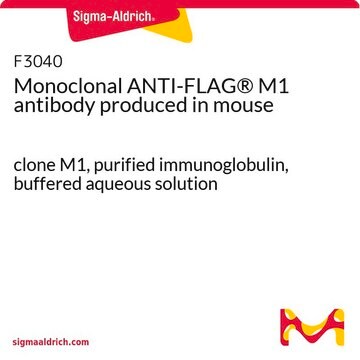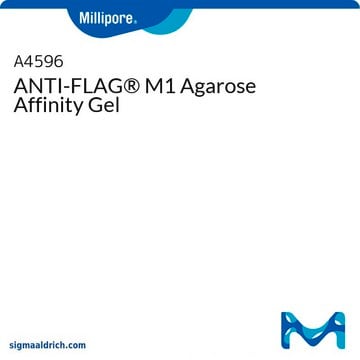F4042
Monoclonal ANTI-FLAG® M5 antibody produced in mouse
clone M5, purified immunoglobulin, buffered aqueous solution
Sinonimo/i:
Anti-ddddk, Anti-dykddddk
About This Item
Prodotti consigliati
Origine biologica
mouse
Coniugato
unconjugated
Forma dell’anticorpo
purified immunoglobulin
Tipo di anticorpo
primary antibodies
Clone
M5, monoclonal
Forma fisica
buffered aqueous solution
Purificato mediante
using Protein A
Reattività contro le specie
all
Concentrazione
2-5 mg/mL
tecniche
western blot (chemiluminescent): 10 μg/mL
Isotipo
IgG1
Sequenza immunogenica
DYKDDDDK
Condizioni di spedizione
dry ice
Temperatura di conservazione
−20°C
Categorie correlate
Descrizione generale
Method of purification - Protein A
Immunogeno
Applicazioni
Stato fisico
Nota sulla preparazione
Altre note
Note legali
Not finding the right product?
Try our Motore di ricerca dei prodotti.
Prodotti correlati
Codice della classe di stoccaggio
12 - Non Combustible Liquids
Classe di pericolosità dell'acqua (WGK)
nwg
Punto d’infiammabilità (°F)
Not applicable
Punto d’infiammabilità (°C)
Not applicable
Certificati d'analisi (COA)
Cerca il Certificati d'analisi (COA) digitando il numero di lotto/batch corrispondente. I numeri di lotto o di batch sono stampati sull'etichetta dei prodotti dopo la parola ‘Lotto’ o ‘Batch’.
Possiedi già questo prodotto?
I documenti relativi ai prodotti acquistati recentemente sono disponibili nell’Archivio dei documenti.
I clienti hanno visto anche
Il team dei nostri ricercatori vanta grande esperienza in tutte le aree della ricerca quali Life Science, scienza dei materiali, sintesi chimica, cromatografia, discipline analitiche, ecc..
Contatta l'Assistenza Tecnica.













